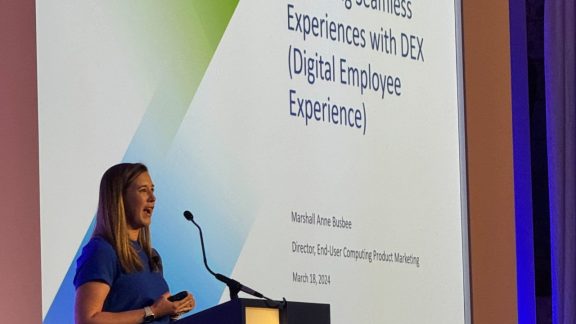Previews for blockbuster movies are always exciting but they all come to an end as the lead-up culminates with the eventual opening weekend that draws hundreds of thousands of excited fans. Similarly, months of anticipation have culminated this week with the launch of Windows 10, the much-anticipated release of the latest Windows operating system that will introduce a new endpoint management paradigm to the industry.
As part of this industry moment, we commissioned a survey with TechValidate to examine the opinions and sentiments of IT professionals towards the Windows update. The survey findings represent feedback from roughly 250 VMware customers and were completed earlier this month.
Through this survey, we discovered some real nuggets of insight from customers , which I’d like to share with you in this post. So without further adieu, below are 5 key takeaways from our recent survey.
1 – IT professionals are generally keen towards Windows 10
- Large majority of IT professionals expect Windows 10 to meet expectations (77%)
- Perceptions about Microsoft appear to be on an upswing with 1 in 3 respondents (34%) having improved their opinion of Microsoft in the last 12 months
- Advanced security (34%), heterogeneous device support (30%) and simpler and faster Windows deployments (19%) are the top three features IT professionals are excited for
- Large majority (69%) expect the Windows 10 migration effort to be about the same as previous Windows OS migration
Microsoft fully understands that there is great appetite for a product that is secure, simple, and easy to manage – factors that are paramount to customers. Windows 10 has some great features in the areas of management, mobility and cloud-enabled functionality. However, the survey results show that customers may not yet fully understand these new capabilities. Despite the availability of EMM-based tools that simplify Windows migrations, most customers expect the actual migration to require approximately the same effort as prior versions of Windows where non-EMM solutions were non-existent. Windows 10 offers the opportunity for enterprise customers to approach management in a fundamentally different and better way. Customers who seize this should benefit from the EMM-based approach to managing configurations, devices, applications, and data.
2 – Customers expect Windows 10 to be difficult to deploy and have doubts about security claims
- Top three concerns among IT professionals are application compatibility (81%), time constraints among staff (56%) and Windows 10 stability (52%)
- Opinions about data security as it relates to heterogeneous device support in Windows 10 are largely evenly split among IT professionals without strong leanings one way or another
Changing the minds of existing and loyal customers is hard, even for Microsoft. Their experience with prior Windows releases leaves many customers expecting Windows 10 to present the usual problems of application compatibility and stability. Further, customers doubt some of the claims that Microsoft is making Windows 10 equally secure for PCs, tablets, and smartphones. We are more optimistic – we believe many customers will be pleasantly surprised with how well Windows 10 runs existing Windows applications and we expect relatively few compatibility issues. Furthermore, we believe that many of the management/deployment challenges of pre-Windows 10 migrations will be largely be a non-issue because of the new EMM techniques that Windows 10 introduces. We encourage customers to begin their Windows 10 testing within the next 3-6 months to begin the process of identifying technical and operational issues.
3 – IT Professionals regard Windows 10 as “just” another operating system
- Large majority identify desktops and laptops as the most relevant platform for their organizational deployment of Windows 10 (90%)
Microsoft is the victim of its own positioning established over 25 years of PC product offerings. Changing the market’s perception of where Windows 10 fits will take effort and time. Windows is most relevant on desktops and laptops, and will likely remain so. Windows desktops have been and remain a staple tool of productivity for organizations, and will continue delivering great value to users. However, Microsoft has struggled extending Windows on non-PC devices. Even though the demand and growth in mobile devices is high, the use of Windows on those mobile devices remains in a minority position. We expect Microsoft to change this “PC-only” perspective over time, as products such as the Surface 3 and Xbox reach broader markets and use cases both in and out of the enterprise.
4 -Survey respondents view VDI as a top delivery model for Windows 10
- More than half (51%) of organizations surveyed plan to use VDI to upgrade to Windows 10
Deploying Windows 10 is more than merely installing an OS on a device. It involves regression testing, application interoperability, integration testing, deployment plans and support models. One way to accelerate testing and adoption is by deploying Windows 10 images in a VDI environment where management and configuration will be quicker and easier. We also believe that VDI-based deployments have become increasingly attractive to wider audiences because of better operations, costs and security. These customer types see Windows 10 migrations as an opportunity to deliver “a better desktop” that is hardware independent, more secure, less costly and is more resilient than conventional PCs.
5 – Enterprise deployment is unlikely before mid-2016
- Most IT professionals (35%) do not plan to deploy Windows 10 for at least another year
Windows migrations traditionally take considerable time (often years) for most organizations, based on factors such as complexity, number of users, locations and type of business. Employing sound project management methodologies requires the right organization, budget, resources, time and justification. Further, organizations do not embark on migration projects without some immediate or pending need such as security, end of support or increased functionality. Many organizations consider OS upgrades when PC refresh projects occur, typically every 4-5 years. Organizations that recently upgraded hardware, have stable Windows 7/8.1 configurations, or have well-managed PCs today will be hard-pressed to build a business justification for early Windows 10 deployments. We do believe that organizations should begin their Windows 10 testing in 2015 with eventual wide-scale adoption beginning in 2016. The management, operational and security benefits of Windows 10 makes the platform significantly more valuable than either Window 7 or 8.1 for organizations and users alike.
In summary, Windows 10 presents customers with an opportunity to apply better management to a broader set of use cases and devices that involves tablets, smartphones, as well as PCs. This holistic end-user computing approach gives customers the ability to unify both desktop and mobile management under one model that will be easier to support, take less effort, is more reliable and more secure. For IT teams searching for solutions to help with their efforts, VMware offers a variety of solutions (AirWatch EMM, Horizon 6, Horizon Air, Mirage Workspace Suite, Horizon FLEX, Fusion 7, Workstation 11) to assist in the migration along with the ongoing management of Windows 10.
When does your organization plan to upgrade to Windows 10? What do you think about the new OS? Let us know in the comment section below.






